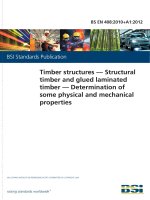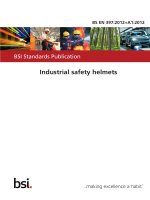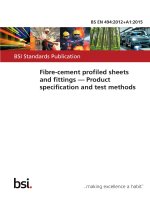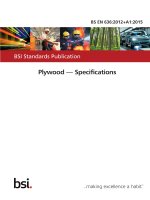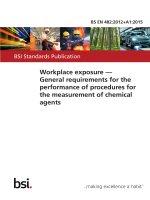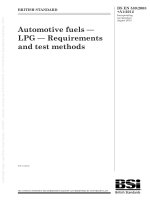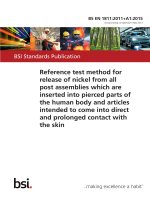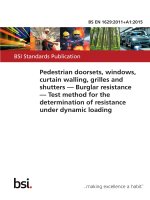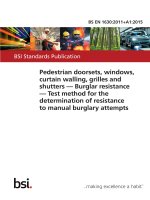Bsi bs en 15030 2012 + a1 2015
Bạn đang xem bản rút gọn của tài liệu. Xem và tải ngay bản đầy đủ của tài liệu tại đây (1.49 MB, 24 trang )
BS EN 15030:2012+A1:2015
BSI Standards Publication
Chemicals used for treatment
of water intended for human
consumption — Silver salts for
intermittent use
BRITISH STANDARD
BS EN 15030:2012+A1:2015
National foreword
This British Standard is the UK implementation of
EN 15030:2012+A1:2015. It supersedes BS EN 15030:2012 which is
withdrawn.
The start and finish of text introduced or altered by amendment is
indicated in the text by tags. Tags indicating changes to CEN text carry
the number of the CEN amendment. For example, text altered by CEN
amendment A1 is indicated by !".
The UK participation in its preparation was entrusted to Technical
Committee CII/59, Chemicals for drinking water treatment.
A list of organizations represented on this committee can be
obtained on request to its secretary.
This publication does not purport to include all the necessary
provisions of a contract. Users are responsible for its correct
application.
© The British Standards Institution 2015.
Published by BSI Standards Limited 2015
ISBN 978 0 580 86573 2
ICS 13.060.20; 71.100.80
Compliance with a British Standard cannot confer immunity from
legal obligations.
This British Standard was published under the authority of the
Standards Policy and Strategy Committee on 28 February 2013.
Amendments/corrigenda issued since publication
Date
Text affected
30 April 2015
Implementation of CEN amendment A1:2015
EUROPEAN STANDARD
EN 15030:2012+A1
NORME EUROPÉENNE
EUROPÄISCHE NORM
March 2015
ICS 71.100.80
Supersedes EN 15030:2012
English Version
Chemicals used for treatment of water intended for human
consumption - Silver salts for intermittent use
Produits chimiques utilisés pour le traitement de l'eau
destinée à la consommation humaine - Sels d'argent pour
usage intermittent
Produkte zur Aufbereitung von Wasser für den
menschlichen Gebrauch - Silbersalze für den nicht
systematischen Gebrauch
This European Standard was approved by CEN on 23 September 2012 and includes Amendment 1 approved by CEN on 5 January 2015.
CEN members are bound to comply with the CEN/CENELEC Internal Regulations which stipulate the conditions for giving this European
Standard the status of a national standard without any alteration. Up-to-date lists and bibliographical references concerning such national
standards may be obtained on application to the CEN-CENELEC Management Centre or to any CEN member.
This European Standard exists in three official versions (English, French, German). A version in any other language made by translation
under the responsibility of a CEN member into its own language and notified to the CEN-CENELEC Management Centre has the same
status as the official versions.
CEN members are the national standards bodies of Austria, Belgium, Bulgaria, Croatia, Cyprus, Czech Republic, Denmark, Estonia,
Finland, Former Yugoslav Republic of Macedonia, France, Germany, Greece, Hungary, Iceland, Ireland, Italy, Latvia, Lithuania,
Luxembourg, Malta, Netherlands, Norway, Poland, Portugal, Romania, Slovakia, Slovenia, Spain, Sweden, Switzerland, Turkey and United
Kingdom.
EUROPEAN COMMITTEE FOR STANDARDIZATION
COMITÉ EUROPÉEN DE NORMALISATION
EUROPÄISCHES KOMITEE FÜR NORMUNG
CEN-CENELEC Management Centre: Avenue Marnix 17, B-1000 Brussels
© 2015 CEN
All rights of exploitation in any form and by any means reserved
worldwide for CEN national Members.
Ref. No. EN 15030:2012+A1:2015 E
BS EN 15030:2012+A1:2015
EN 15030:2012+A1:2015 (E)
Contents
Page
Foreword ...................................................................................................................................................................... 3
Introduction ................................................................................................................................................................. 4
1
Scope .............................................................................................................................................................. 5
2
Normative references .................................................................................................................................... 5
3
Description ..................................................................................................................................................... 6
4
Purity criteria .................................................................................................................................................. 9
5
Test methods................................................................................................................................................ 10
6
Labelling - transportation - storage ........................................................................................................... 13
Annex A (informative) General information on silver salts ................................................................................. 16
Annex B (normative) General rules relating to safety .......................................................................................... 18
Annex C (informative) Environmental, health and safety precautions within the chemical
laboratory ..................................................................................................................................................... 19
Bibliography .............................................................................................................................................................. 20
2
BS EN 15030:2012+A1:2015
EN 15030:2012+A1:2015 (E)
Foreword
This document (EN 15030:2012+A1:2015) has been prepared by Technical Committee CEN/TC 164 “Water
supply”, the secretariat of which is held by AFNOR.
This European Standard shall be given the status of a national standard, either by publication of an identical
text or by endorsement, at the latest by September 2015, and conflicting national standards shall be
withdrawn at the latest by September 2015.
Attention is drawn to the possibility that some of the elements of this document may be the subject of patent
rights. CEN [and/or CENELEC] shall not be held responsible for identifying any or all such patent rights.
This document supersedes !EN 15030:2012".
This document includes Amendment 1 approved by CEN on 2015-01-04.
The start and finish of text introduced or altered by amendment is indicated in the text by tags !".
The significant technical differences between this edition and EN 15030:2006 are as follows:
—
Modification of 6.2 on labelling, deletion of the reference to EU Directive 80/778/EEC of 15 July 1980 in
order to take account of the latest Directive in force.
According to the CEN/CENELEC Internal Regulations, the national standards organizations of the following
countries are bound to implement this European Standard: Austria, Belgium, Bulgaria, Croatia, Cyprus, Czech
Republic, Denmark, Estonia, Finland, Former Yugoslav Republic of Macedonia, France, Germany, Greece,
Hungary, Iceland, Ireland, Italy, Latvia, Lithuania, Luxembourg, Malta, Netherlands, Norway, Poland, Portugal,
Romania, Slovakia, Slovenia, Spain, Sweden, Switzerland, Turkey and the United Kingdom.
3
BS EN 15030:2012+A1:2015
EN 15030:2012+A1:2015 (E)
Introduction
In respect of potential adverse effects on the quality of water intended for human consumption caused by the
products covered by this European Standard:
a)
this European Standard provides no information as to whether the products may be used without
restriction in any of the Member States of the EU or EFTA;
b)
it should be noted that, while awaiting the adoption of verifiable European criteria, existing national
regulations concerning the use and/or the characteristics of these products remain in force.
!NOTE 1"
Conformity with this European Standard does not confer or imply acceptance or approval of the
products in any of the member states of the EU or EFTA. The use of the products covered by this European Standard is
subject to regulation or control by national authorities.
!NOTE 2
These products are used as biocides and comply with the relevant legislation in force. In the European
Union, at the time of publication, this legislation is Regulation (EU) No 528/2012 [1]."
Water which is to be preserved with silver !ions" should fulfil the relevant legal requirements before the
silver salt is added, in particular microbiological requirements.
4
BS EN 15030:2012+A1:2015
EN 15030:2012+A1:2015 (E)
1
Scope
This European Standard is applicable to silver nitrate and silver sulfate !and silver chloride" for the
preservation of water intended for human consumption in intermittent applications in:
—
water supply plants, including their pipeline networks (small-size plants);
—
water for the preparation of foodstuffs;
—
water which is stored in packaged form or kept in enclosed systems (for example, water supply systems
in land, water and airborne vehicles).
The purpose of adding silver salts is to prevent the detrimental proliferation of microorganisms in water during
storage or in enclosed supply systems.
This European Standard describes the characteristics of silver salts, specifies the requirements for silver salts
and gives reference to the analytical methods. It gives information on their use in water treatment. It also
determines the rules relating to safe handling and use of silver salts (see Annex B).
2
Normative references
The following documents, in whole or in part, are normatively referenced in this document and are
indispensable for its application. For dated references, only the edition cited applies. For undated references,
the latest edition of the referenced document (including any amendments) applies.
EN 1233, Water quality — Determination of chromium — Atomic absorption spectrometric methods
EN ISO 3696, Water for analytical laboratory use — Specification and test methods (ISO 3696)
EN ISO 5961, Water quality — Determination of cadmium by atomic absorption spectrometry (ISO 5961)
EN ISO 10304-1, Water quality — Determination of dissolved anions by liquid chromatography of ions — Part
1: Determination of bromide, chloride, fluoride, nitrate, nitrite, phosphate and sulphate (ISO 10304-1)
EN ISO 11885, Water quality — Determination of selected elements by inductively coupled plasma optical
emission spectrometry (ICP-OES) (ISO 11885)
EN ISO 11969, Water quality — Determination of arsenic — Atomic absorption spectrometric method (hydride
technique) (ISO 11969)
EN ISO 12846, Water quality — Determination of mercury — Method using atomic absorption spectrometry
(AAS) with and without enrichment (ISO 12846)
ISO 3165, Sampling of chemical products for industrial use — Safety in sampling
ISO 6206, Chemical products for industrial use — Sampling — Vocabulary
ISO 8213, Chemical products for industrial use — Sampling techniques — Solid chemical products in the form
of particles varying from powders to coarse lumps
ISO 8288:1986, Water quality — Determination of cobalt, nickel, copper, zinc, cadmium and lead — Flame
atomic absorption spectrometric methods
5
BS EN 15030:2012+A1:2015
EN 15030:2012+A1:2015 (E)
ISO 9965, Water quality — Determination of selenium — Atomic absorption spectrometric method (hydride
technique)
3
Description
3.1
Identification
3.1.1
Chemical name
a)
Silver nitrate;
b)
Silver sulfate;
!
c)
silver chloride."
3.1.2
Synonym or common name
!The naturally occurring mineral is called chlorargyrite or cerargirite, if weathered by air named as horn
silver."
3.1.3
Relative molecular mass
a)
169,87;
b)
311,97;
!
c)
143,23."
3.1.4
Empirical formula
a)
AgNO3;
b)
Ag2SO4;
!
c)
AgCl."
3.1.5
Chemical formula
a)
AgNO3;
b)
Ag2SO4;
!
c)
6
AgCl."
BS EN 15030:2012+A1:2015
EN 15030:2012+A1:2015 (E)
3.1.6
CAS Registry Number 1)
a)
7761-88-8;
b)
10294-26-5;
!
c)
7783-90-6."
3.1.7
!EINECS number" 2)
a)
231-853-9;
b)
233-653-7;
!
c)
232-033-3."
3.2
Commercial forms
!The products are solids, available as powders or pelletized."
3.3
Physical properties
3.3.1
Appearance
!White to slightly grey or yellowish.
NOTE
Silver chloride quickly darkens on exposure to light by disintegrating into elemental chlorine and metallic silver;
the latter is responsible for the colour change."
3.3.2
Density
!
3
a)
4,35 g/cm (crystal density);
b)
5,45 g/cm (crystal density);
c)
5,56 g/cm (crystal density)."
3
3
3.3.3
Solubility (in water)
!
a)
2,16 g/l;
b)
8 g/l;
1)
Chemical Abstracts Service Registry Number.
2)
European Inventory of Existing Commercial Chemical Substances.
7
BS EN 15030:2012+A1:2015
EN 15030:2012+A1:2015 (E)
c)
1,88 mg/l at 25 °C."
3.3.4
Vapour pressure at 20 °C
Not applicable.
3.3.5
Boiling point at 100 kPa 3)
!
a)
444 °C (decomposition);
b)
1 085 °C (decomposition);
c)
1 550 °C."
3.3.6
Melting point
!
a)
212 °C;
b)
652 °C;
c)
455 °C."
3.3.7
Specific heat
Not known.
3.3.8
Viscosity (dynamic)
Not applicable.
3.3.9
Critical temperature
Not applicable.
3.3.10 Critical pressure
Not applicable.
3.3.11 Physical hardness
Not applicable.
3.4
a)
3)
8
Chemical properties
silver nitrate in solution is almost neutral (the pH value of an aqueous solution at 100 g/l is
approximately 6);
100 kPa = 1 bar.
BS EN 15030:2012+A1:2015
EN 15030:2012+A1:2015 (E)
b)
silver sulfate in solution is almost neutral (the pH value of an aqueous solution at 5 g/l is
approximately 5 to 6);
!
c)
the saturated aqueous solution (see 3.3.3) is pH neutral. Silver chloride is insoluble in alcohol, other
organic solvents, dilute acids and concentrated nitric acid, but soluble in concentrated sulphuric acid and
(depending on the individual concentration) in aqueous solutions of ammonia, chlorides, bromides,
thiosulfates and cyanides under complexation of the silver ion.
0
The standard redox potential (E ) of Ag+/Ag in neutral aqueous solution at 25 °C is: E° = +0,80 V.
0
The standard redox potential (E ) of AgCl/Ag in neutral solution at 25 °C is: E° = +0,22 V."
4
4.1
Purity criteria
General
This European Standard specifies the minimum purity requirements for silvers salts used for the preservation
of water intended for human consumption. Limits are given for impurities commonly present in the products.
Depending on the raw material and the manufacturing process other impurities may be present and, if so, this
shall be notified to the user and when necessary to relevant authorities.
Users of the products should check the national regulations in order to clarify whether it is of appropriate purity
for the preservation of water intended for human consumption, taking into account water quality, required
dosage, contents of other impurities and additives used in the products not stated in this product standard.
Limits have been given for impurities and chemical parameters where these are likely to be present in
significant quantities from the current production process and raw materials. If the production process or raw
materials lead to significant quantities of impurities, by-products or additives being present, this shall be
notified to the user.
4.2
Composition of commercial products
!The content of silver salts shall not be less than a mass fraction of 99 %."
4.3
Impurities and main by-products
The products shall conform to the requirements specified in Table 1.
9
BS EN 15030:2012+A1:2015
EN 15030:2012+A1:2015 (E)
!
Table 1 — Impurities
Impurity
Limit
mg/kg of product
a) Silver nitrate
b) Silver sulfate
c) Silver chloride
Chloride (Cl–)
max.
1
n.a.
n.a.
Copper (Cu)
max.
0,056
100
30
Iron (Fe)
max.
0,255
50
30
Nitrite (NO2–)
max.
0,5
n.a.
n.a.
Sulfate (SO42–)
max.
5
n.a.
n.a.
NOTE
n.a. = not applicable
"
4.4
Chemical parameters
The products shall conform to the requirements specified in Table 2.
!
Table 2 — Chemical parameters
Parameter
Limit
mg/kg of product
a) Silver nitrate
b) Silver sulfate
c) Silver chloride
Arsenic (As)
max.
5
5
6
Cadmium (Cd)
max.
10
10
12
Chromium (Cr)
max.
10
10
12
Mercury (Hg)
max.
1
1
1,2
Nickel (Ni)
max.
10
10
12
Lead (Pb)
max.
10
10
12
Antimony (Sb)
max.
10
10
12
Selenium (Se)
max.
10
10
12
NOTE
Cyanide is not relevant, since the materials used in the production process are free from
it. Pesticides and polycyclic aromatic hydrocarbons are not by-products of the production process.
For parametric values of trace metal content in drinking water, see [2].
"
5
5.1
Test methods
Sampling
Observe the general recommendations of ISO 3165 and take into account ISO 6206.
Prepare the laboratory sample(s) required by the relevant procedure described in ISO 8213.
10
BS EN 15030:2012+A1:2015
EN 15030:2012+A1:2015 (E)
5.2
Analyses
5.2.1
Silver content (main product)
The silver content shall be determined in accordance with EN ISO 11885.
5.2.2
Impurities
5.2.2.1
Sulfate
The sulfate (SO42-) content shall be determined in accordance with EN ISO 10304-1.
An alternative method may be used as described in EN ISO 10304-2 and this should be notified to the user.
5.2.2.2
Chloride
The chloride (Cl-) content shall be determined in accordance with EN ISO 10304-1.
5.2.2.3
Metallic impurities
!The metallic impurities iron and copper shall be determined in accordance with EN ISO 11885."
5.2.2.4
Nitrite
The nitrite (NO2-) content shall be determined in accordance with EN ISO 10304-1.
An alternative method may be used as described in EN ISO 13395 and this should be notified to the user.
5.2.3
Chemical parameters
When preparing the silver salts for analysis, it is important to ensure that the chemical parameters are
effectively dissolved. The concentration of the solution should be sufficient to permit adequate sensitivity in
analysis of chemical parameters.
5.2.3.1
Determination of antimony (Sb), arsenic (As), cadmium (Cd), chromium (Cr), lead (Pb),
mercury (Hg), nickel (Ni) and selenium (Se)
5.2.3.1.1
Principle
The elements antimony, arsenic, cadmium, chromium, lead, mercury, nickel and selenium are determined by
atomic absorption spectrometry.
5.2.3.1.2
Reagents
All reagents shall be of a recognised analytical grade and the water used shall conform to grade 3 as specified
in EN ISO 3696.
5.2.3.1.2.1
Hydrochloric acid, concentrated density p = 1,18 g/ml.
11
BS EN 15030:2012+A1:2015
EN 15030:2012+A1:2015 (E)
!
5.2.3.1.2.2
5.2.3.1.3
5.2.3.1.3.1
Sodium thiosulfate solution, 10 % (m/m)"
Procedure
Test portion
Weigh, to the nearest 0,001 g, 2,5 g (m) from the laboratory sample into a 100 ml one-mark volumetric flask.
!
5.2.3.1.3.2
Test solution for AgNO3 and Ag2SO4"
Add 20 ml of water and 2 ml of the hydrochloric acid (5.2.3.1.2.1), dissolve and make up to the mark with
water and mix.
!
5.2.3.1.3.3
Test solution for AgCl
Add 20 ml of water and 2 ml of the sodium thiosulfate solution (5.2.3.1.2.2) dissolve and make up to the mark
with water and mix."
5.2.3.1.3.4
Determination
Determine the content of elements in the test solution (5.2.3.1.3.2 !or 5.2.3.1.3.3") in accordance with the
following methods:
—
Cd: in accordance with EN ISO 5961;
—
Ni: in accordance with ISO 8288:1986, Method C;
An alternative method may be used as described in EN ISO 11885 and this should be notified to the user.
—
Pb: in accordance with ISO 8288:1986, Method C;
An alternative method may be used as described in EN ISO 5961 and this should be notified to the user.
—
Cr: in accordance with EN 1233;
An alternative method may be used as described in EN ISO 11885 and this should be notified to the user.
—
As: in accordance with EN ISO 11969;
—
Se: in accordance with ISO 9965;
—
Sb: in accordance with EN ISO 11885;
—
Hg: in accordance with EN ISO 12846.
These methods provide an interim result (y) expressed in milligrams per litre which needs to be converted to
give the final concentration according to !Formula (1) in 5.2.3.1.3.5".
12
BS EN 15030:2012+A1:2015
EN 15030:2012+A1:2015 (E)
5.2.3.1.3.5
Expression of results
From the interim result (y) determined (see !5.2.3.1.3.4"), the content c1 of each element in the laboratory
sample, expressed in milligrams per kilogram of silver salt, is given by the following formula:
c1 = yx
V
x100
m
(1)
where
y
is the interim result (!5.2.3.1.3.4");
V
is the volume, expressed in millilitres, of the test solution (!5.2.3.1.3.3") (= 100 ml);
m
is the mass, expressed in gram of the test portion.
6
Labelling - transportation - storage
6.1
Means of delivery
!The products shall be delivered in containers made from polyethylene or other suitable materials. The
products shall not get in contact with aluminium and its alloys, which can be corroded."
NOTE
The manufacturer can provide advice on suitable materials.
In order that the purity of the product is not affected, the means of delivery shall not have been used
previously for any different product or it shall have been specially cleaned and prepared before use.
6.2
Labelling in accordance with the EU legislation 4)
!The following labelling requirements apply to silver salts at the date of the publication of this European
Standard.
a)
Silver nitrate:
— Pictograms:
GHS03
—
4)
Signal word:
GHS05
GHS09
Danger;
See [2].
13
BS EN 15030:2012+A1:2015
EN 15030:2012+A1:2015 (E)
—
Hazard statements:
H272: May intensify fire; oxidizer;
H314: Causes severe skin burns and eye damage;
H410: Very toxic to aquatic life with long lasting effects.
b)
Silver sulfate:
At the date of publication of this document, Silver sulfate is not listed within Annex VI of [3];
c)
Silver chloride:
At the date of publication of this document, Silver chloride is not listed within Annex VI of [3].
The legislation [3], and its amendments for the purposes of its adaptation to technical and scientific progress,
contains a list of substances classified by the EU. Substances not listed in this regulation have to be classified
on the basis of their intrinsic properties according to the criteria in the regulation by the person responsible for
the marketing of the substance."
6.3
Transportation regulations and labelling
!
a)
Silver nitrate is listed under a UN number 5) 1493.
— RID 6) / ADR 7): class 5.1; classification code O2; packing group II;
— IMDG 8): class 5.1;
— IATA 9): class 5.1.
b) and c): Silver sulfate and silver chloride are not classified as a dangerous product for road, rail, sea and air
transportation."
6.4
Marking
The marking shall include the following information:
—
name: "silver nitrate" or "silver sulfate" !or "silver chloride"" trade name and grade;
—
net mass;
—
name and the address of the supplier and/or manufacturer;
—
statement "This product conforms to EN 15030".
5)
United Nations Number.
6)
Regulations concerning International carriage of Dangerous goods by rail.
7)
European Agreement concerning the international carriage of Dangerous goods by Road.
8)
International Maritime transport of Dangerous Goods.
9)
International Air Transport Association.
14
BS EN 15030:2012+A1:2015
EN 15030:2012+A1:2015 (E)
6.5
6.5.1
Storage
General
!The products shall be stored in tightly closed, light-tight containers and kept in a cool, dry place protected
against sun light. They shall be stored under hygienic and safe conditions to avoid any risk of
contamination." Storage tanks shall be of a corrosion-resistant material suitable for the purpose.
NOTE
The manufacturer can provide advice on suitable materials.
!deleted text"
6.5.2
Long-term stability
If properly stored, the products will remain in a stable state for a prolonged period of time, with no loss of
efficacy.
6.5.3
Storage incompatibilities
!The products shall not come into contact with ammonia gas, azides and acetylene gas as highly explosive
silver compounds can be formed."
15
BS EN 15030:2012+A1:2015
EN 15030:2012+A1:2015 (E)
Annex A
(informative)
General information on silver salts
A.1 General
!
A.1.1 Manufacture
Silver chloride is made by precipitating silver ions with chloride ions in aqueous solution, usually by reaction of
silver nitrate solution (well soluble silver salt) with alkali chloride solutions or hydrochloric acid. The sparingly
soluble silver chloride precipitate is washed with water, filtered off and dried."
A.1.2 Effect
The silver ion is the effective component of the compounds in the preservation of drinking water. These silver
ions are electrically charged particles of silver on the scale of atoms. They penetrate the cell wall of the
bacteria and cause a blockage of the enzyme system by inhibiting vital conversions into micro-organisms.
Thiol and carboxyl groups in particular form comparatively stable compounds with the silver ions.
The bacterial cells are not (or only partly) destroyed by silver ions. Depending on the ambient conditions, they
are reactivated after a time (one month to six months) and can then proliferate. Through the addition of silver
ions, drinking water can be protected against re-growth for up to six months, depending on ambient factors
and the substances in the water. The basic precondition for the use of the compounds referred to is a water
quality compliant with !EU Directive 98/83/EC [2]", a clean container and a reaction time of at least 2 h.
Organic water ingredients (TOC) and chlorides can reduce the effect of the silver salts. As the temperature
rises, the !microbiocidal" effect becomes stronger in step with the increase in ionisation.
A.1.3 Application
The products described can be used for the preservation of water for human consumption in intermittent
application in water supply plants, including their pipeline networks, with a maximum annual outflow of
1 000 m³ (small-size plants). It is the same for the preservation of water for the preparation of foodstuffs, water
which is kept in enclosed systems (e.g. water supply systems in land-, water- and airborne vehicles) or, in
exceptional cases, water which is stored for emergencies.
The term “intermittent use” in the context of this European Standard means the non-systematic use, and the
use on demand of silver salts respectively for the preservation of water (drinking water):
—
in case of interruption of operation in small-size plants for a prolonged period of time or if, as a result of
low consumption and lengthy storage periods it can be assumed that the water supplied for human
consumption will not meet the microbiological requirements of drinking water;
—
in food processing plants the preservation of drinking water as required - water which needs to be
protected against possible re-growth on account of its intended use;
—
in mobile systems in land, water and airborne vehicles which pick up drinking water at different locations
as opposed to the permanent or systematic use in a public drinking water supply (large plants with fixed
pipeline networks and continuous feed).
16
BS EN 15030:2012+A1:2015
EN 15030:2012+A1:2015 (E)
The term “exceptional case” means, in the context of this European Standard, the use of silver salts for the
preservation of water for emergencies e.g. packed drinking water.
A.2 Use
A.2.1 Form in which it is used
a)
The products described are not used in pure substance form.
b)
They are mixed with sodium chloride and are available in the form of tablets, powder or an aqueous
solution referred to generally as "silver chloro complex".
!
c)
Silver chloride is used as such or mixed with solid sodium chloride (in the form of tablets or powder) or
dissolved in an aqueous solution of sodium chloride (NaCl) to improve the speed of dissolution since pure
silver chloride is only slowly dissolving in water."
!Sodium chloride used for preparing solutions of silver chloride should conform to EN 973 [4]."
A.2.2 Treatment dose
!This refers to concentration of the active silver ions: the concentration of silver ions in the treated water
adjusts to 0,05 mg/l to 0,10 mg/l due to the formation of sparingly soluble silver chloride or carbonate,
irrespective of the basic concentrate of the added commercial product."
A.2.3 Means of application
The type of application is dependent on the commercial product.
A.2.4 Secondary effects
!If applied in mixture with sodium chloride, a small increase of chloride ions can occur, depending on the
amount of NaCl."
17
BS EN 15030:2012+A1:2015
EN 15030:2012+A1:2015 (E)
Annex B
(normative)
General rules relating to safety
B.1 Rules for safe handling and use
The supplier shall provide current safety instructions.
B.2 Emergency procedures
B.2.1 First aid
!In case of contact with the skin rinse affected area thoroughly with water; contaminated clothing shall be
removed.
In case of contact with the eyes rinse the eyes thoroughly with water and seek immediately advice of an eye
doctor.
In case of ingestion rinse out the mouth with water, give the person affected water to drink and seek
immediately medical advice.
In case of inhalation of dust seek immediately medical advice."
B.2.2 Spillage
Collect and store the silver salts in separate plastic containers. Make sure that any spilled material does not
enter the storage container, the waste material bin or the wastewater system. Local regulations for the proper
disposal of such substances shall also be strictly adhered to.
B.2.3 Fire
!The products are non-flammable, but silver nitrate is an oxidiser. Use water to extinguish surrounding fires
and to cool down any inflammable containers with pressurised gases (e.g. chlorine cylinders) or flammable
gases or liquids. Collect potentially contaminated fire fighting water, do not let drain into sewage or natural
waters."
18
BS EN 15030:2012+A1:2015
EN 15030:2012+A1:2015 (E)
Annex C
(informative)
Environmental, health and safety precautions within the chemical
laboratory
When preparing the analytical methods for application of this European Standard, consideration was given to
the minimisation of environmental impacts caused by the use of the methods of analysis.
It is the user’s responsibility to use safe and proper techniques in handling materials in the methods of
analysis specified in this European Standard.
The following list is not exhaustive but users of the analytical methods referred in this European Standard may
use it as a guide to the use of safe and proper techniques. They should:
—
investigate if European Directives, transposed European legislation and national laws, regulations and
administrative provisions apply;
—
consult manufacturers/suppliers for specific details such as material safety data sheets and other
recommendations;
—
use safety equipment and wear protective clothing, usually goggles and coats, appropriate for the test
product and the test chemicals, in all laboratory areas, to ensure the safety of the operator;
—
be careful about flammable materials and substances that are toxic and/or human carcinogens and
generally take care during transportation, decanting, diluting and dealing with spillages;
—
use a fume cupboard during preparation of organic solvent solutions;
—
store, handle and dispose of chemicals in a safe and environmentally satisfactory manner: including
chemicals for laboratory test, test specimens, unused solvents and reagents that have to be disposed of.
19
BS EN 15030:2012+A1:2015
EN 15030:2012+A1:2015 (E)
Bibliography
!
[1]
Regulation (EU) No 528/2012 of the European Parliament and of the Council of 22 May 2012
concerning the making available on the market and use of biocidal products
[2]
Directive 98/83/EC, Council Directive of 3 November 1998 on the quality of water intended for human
consumption
[3]
Regulation (EC) No 1272/2008 of the European Parliament and of the Council of 16 December 2008
on classification, labelling and packaging of substances and mixtures, amending and repealing
Directives 67/548/EEC and 1999/45/EC, and amending Regulation (EC) No 1907/2006 (REACH)
[4]
EN 973, Chemicals used for treatment of water intended for human consumption ― Sodium chloride
for regeneration of ion exchangers
"
20
This page deliberately left blank
NO COPYING WITHOUT BSI PERMISSION EXCEPT AS PERMITTED BY COPYRIGHT LAW
British Standards Institution (BSI)
BSI is the national body responsible for preparing British Standards and other
standards-related publications, information and services.
BSI is incorporated by Royal Charter. British Standards and other standardization
products are published by BSI Standards Limited.
About us
Revisions
We bring together business, industry, government, consumers, innovators
and others to shape their combined experience and expertise into standards
-based solutions.
Our British Standards and other publications are updated by amendment or revision.
The knowledge embodied in our standards has been carefully assembled in
a dependable format and refined through our open consultation process.
Organizations of all sizes and across all sectors choose standards to help
them achieve their goals.
Information on standards
We can provide you with the knowledge that your organization needs
to succeed. Find out more about British Standards by visiting our website at
bsigroup.com/standards or contacting our Customer Services team or
Knowledge Centre.
Buying standards
You can buy and download PDF versions of BSI publications, including British
and adopted European and international standards, through our website at
bsigroup.com/shop, where hard copies can also be purchased.
If you need international and foreign standards from other Standards Development
Organizations, hard copies can be ordered from our Customer Services team.
Subscriptions
Our range of subscription services are designed to make using standards
easier for you. For further information on our subscription products go to
bsigroup.com/subscriptions.
With British Standards Online (BSOL) you’ll have instant access to over 55,000
British and adopted European and international standards from your desktop.
It’s available 24/7 and is refreshed daily so you’ll always be up to date.
You can keep in touch with standards developments and receive substantial
discounts on the purchase price of standards, both in single copy and subscription
format, by becoming a BSI Subscribing Member.
PLUS is an updating service exclusive to BSI Subscribing Members. You will
automatically receive the latest hard copy of your standards when they’re
revised or replaced.
To find out more about becoming a BSI Subscribing Member and the benefits
of membership, please visit bsigroup.com/shop.
With a Multi-User Network Licence (MUNL) you are able to host standards
publications on your intranet. Licences can cover as few or as many users as you
wish. With updates supplied as soon as they’re available, you can be sure your
documentation is current. For further information, email
BSI Group Headquarters
389 Chiswick High Road London W4 4AL UK
We continually improve the quality of our products and services to benefit your
business. If you find an inaccuracy or ambiguity within a British Standard or other
BSI publication please inform the Knowledge Centre.
Copyright
All the data, software and documentation set out in all British Standards and
other BSI publications are the property of and copyrighted by BSI, or some person
or entity that owns copyright in the information used (such as the international
standardization bodies) and has formally licensed such information to BSI for
commercial publication and use. Except as permitted under the Copyright, Designs
and Patents Act 1988 no extract may be reproduced, stored in a retrieval system
or transmitted in any form or by any means – electronic, photocopying, recording
or otherwise – without prior written permission from BSI. Details and advice can
be obtained from the Copyright & Licensing Department.
Useful Contacts:
Customer Services
Tel: +44 845 086 9001
Email (orders):
Email (enquiries):
Subscriptions
Tel: +44 845 086 9001
Email:
Knowledge Centre
Tel: +44 20 8996 7004
Email:
Copyright & Licensing
Tel: +44 20 8996 7070
Email:
